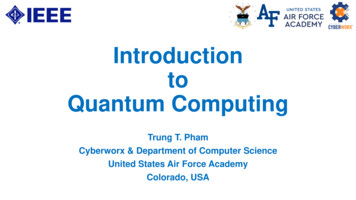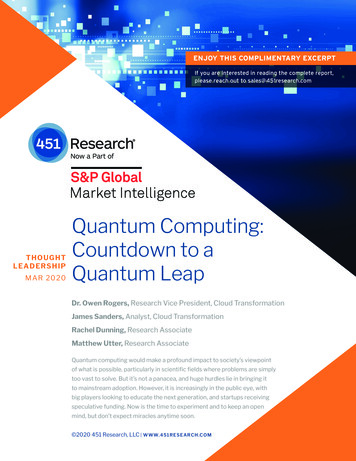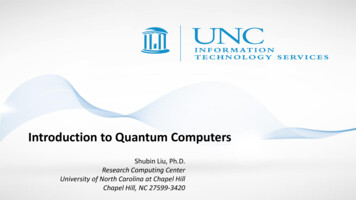
Transcription
IntroductiontoQuantum ComputingTrung T. PhamCyberworx & Department of Computer ScienceUnited States Air Force AcademyColorado, USA
Agenda Introduction Traditional Digital Computers Concept of Quantum Computers Quantum Computing Research Topics & Applications Conclusion
Introduction Digital computers have been popularized through theirimplementation in various devices that we use in oureveryday routines
Introduction Digital computers have been popularized through theirimplementation in various devices that we use in oureveryday routines
Introduction As digital computers gain more computational power, moresoftware applications were developed to help every aspectof our lives the ubiquity of computers in our daily lives makes digitalcomputers even more popular the thirst for more computing power is a good motivation to pushthe state of the arts further
Introduction One direction of pushing the state of the art incomputational power is the concept of developing aquantum computer the continuous state inside a quantum computer can simplifycomputation scheme and improve efficiency faster computation will allow more sophisticated softwareapplication beyond imagination
Traditional Digital Computers Traditional digital computers were built based on hardwarethat can represent and process binary data electronic components rely on using measurable electricalvoltage to represent data high voltage of 5V was used to represent a 1 and low voltage of 0Vwas used to represent a 0 electronic hardware was designed to have output of either 5V or0V
Traditional Digital Computers Traditional digital computers were built around the basicdigital circuits representing logical AND and logical ORoperatorslogical AND gatelogical OR gate
Traditional Digital Computers0V0V0Vlogical AND gate
Traditional Digital Computers5V0V0Vlogical AND gate
Traditional Digital Computers0V0V0Vlogical AND gate
Traditional Digital Computers0V0V5Vlogical AND gate
Traditional Digital Computers0V0V0Vlogical AND gate
Traditional Digital Computers5V5V5Vlogical AND gate
Traditional Digital Computers
Traditional Digital Computers0V0V0Vlogical OR gate
Traditional Digital Computers5V5V0Vlogical OR gate
Traditional Digital Computers0V0V0Vlogical OR gate
Traditional Digital Computers0V5V5Vlogical OR gate
Traditional Digital Computers0V0V0Vlogical OR gate
Traditional Digital Computers5V5V5Vlogical OR gate
Traditional Digital Computers
Traditional Digital Computers Logical AND gate and logical OR gates are combined tobuild: flip-flop: a basic unit of memory adder: basic unit of computation
Traditional Digital Computers0V0Vinputoutputflip-flop
Traditional Digital Computers5V0Vinputoutputflip-flop
Traditional Digital Computers5V5Vinputoutputflip-flop
Traditional Digital Computers0V5Vinputoutputflip-flop
Traditional Digital Computers5V5Vinputoutputflip-flop
Traditional Digital Computers5V0Vinputoutputflip-flop
Traditional Digital Computers0V0Vinputoutputflip-flop
Traditional Digital Computers
Traditional Digital Computers0V0VInput first bitOutput sumInput second bit0VOutput carry over bit0Vadder
Traditional Digital Computers5V5VInput first bitOutput sumInput second bit0VOutput carry over bit0Vadder
Traditional Digital Computers0V0VInput first bitOutput sumInput second bit0VOutput carry over bit0Vadder
Traditional Digital Computers0V5VInput first bitOutput sumInput second bit5VOutput carry over bit0Vadder
Traditional Digital Computers0V0VInput first bitOutput sumInput second bit0VOutput carry over bit0Vadder
Traditional Digital Computers5V0VInput first bitOutput sumInput second bit5VOutput carry over bit5Vadder
Traditional Digital Computers0V0VInput first bitOutput sumInput second bit0VOutput carry over bit0Vadder
Traditional Digital Computers
Traditional Digital Computers Software was developed around a context-free language toinstruct a digital computer of what to do variable: an allocated memory area to hold data operator: an instruction of what to do with the data stored in thevariables
Traditional Digital Computersmain(){}
Traditional Digital Computersmain(){int myVariable 50;}allocate memory
Traditional Digital Computersmain(){int myVariable 50;}assign data contentmyVariagle
Traditional Digital Computersmain(){int myVariable 50;int myResult myVariable 1;}myVariagle
Traditional Digital Computersmain(){int myVariable 50;int myResult myVariable 1;}myVariagleallocate memory
Traditional Digital Computersmain(){int myVariable 50;int myResult myVariable 1;}myVariaglemyResultcalculate and assign data content
Traditional Digital Computersmain(){int myVariable 50;int myResult myVariable 1;printf();}myVariaglemyResult
Traditional Digital Computers Traditional digital computers combine both hardware andsoftware together so that users see only an integrated product that can be configuredaccording to the needs the software platform can be updated automatically to improve theperformance
Concept of Quantum Computers
Concept of Quantum Computers Quantum computers are computers that designed and builtbased on the hardware that can represent and process datain the quantum state electronic components rely on using measurable electricalvoltage to represent data voltage can be varied between an acceptable range to representdata in the quantum state electronic hardware was designed to accept, process, andproduce data in the quantum state
Concept of Quantum Computers Quantum bit is the smallest unit of data in a quantumcomputer a quantum bit consists of two parts representing the quantumstates of the two binary outcomes voltage can be varied between an acceptable range to representdata in the quantum state electronic hardware was designed to accept, process, andproduce data in the quantum state
Concept of Quantum Computers A quantum bit is represented by a linear combination oftwo orthogonal vectors 0 [1 0]T and 1 [0 1]Tbquantum 0 1 Where is the probability of 0 and is the probability of 1 , and 2 2 1
Concept of Quantum Computers Similar to logic gates in traditional digital computer, thereare various gates designed for quantum computers Pauli X gate: an equivalent of the NOT gate reversing the binarydata SWAP gate: swapping the two input quantum bits
Concept of Quantum Computers Similar to logic gates in traditional digital computer, thereare various gates designed for quantum computers definitions of more gates can be found athttps://en.wikipedia.org/wiki/Quantum logic gate
Concept of Quantum Computers
Concept of Quantum Computers output0 output1XinputquantumbitPauli X gate10 input inputoutputquantumbit
Concept of Quantum Computers output0 output1XinputquantumbitPauli X gate10 input inputoutputquantumbit
Concept of Quantum Computers output0 output1XinputquantumbitPauli X gate10 input inputoutputquantumbit
Concept of Quantum Computers output0 output1XinputquantumbitPauli X gate10 input inputoutputquantumbit
Concept of Quantum Computers output0 output1XinputquantumbitPauli X gate10 input inputoutputquantumbit
Concept of Quantum Computers output0 output1XinputquantumbitPauli X gate10 input inputoutputquantumbit
Concept of Quantum Computers output0 output1XinputquantumbitPauli X gate10 input inputoutputquantumbit
Concept of Quantum Computers output0 output1XinputquantumbitPauli X gate10 input inputoutputquantumbit
Concept of Quantum Computers output0 output1XinputquantumbitPauli X gate10 input inputoutputquantumbit
Concept of Quantum Computers output0 output1XinputquantumbitPauli X gate10 input inputoutputquantumbit
Concept of Quantum Computers output0 output1XinputquantumbitPauli X gate10 input inputoutputquantumbit
Concept of Quantum Computers output0 output1XinputquantumbitPauli X gate10 input inputoutputquantumbit
Concept of Quantum Computers output0 output1XinputquantumbitPauli X gate10 input inputoutputquantumbit
Concept of Quantum Computers
Concept of Quantum Computers input,1 input,1 input,2 input,2combining two quantum bits into a vectorfor mathematical calculation
Concept of Quantum Computers input,1 input,1 input,2 input,2 input,1 input,2 input,2 input,1 input,2 input,2combining two quantum bits into a vectorfor mathematical calculation
Concept of Quantum Computers input,1 input,1 input,2 input,2 input,1 input,1 input,2 input,2 input,2 input,2combining two quantum bits into a vectorfor mathematical calculation input,1 input,2 input,1 input,2 input,1 input,2 input,1 input,2
Concept of Quantum Computersvoutput,00voutput,01voutput,10voutput,11 1000001001000001mathematical representation ofSWAP gatevinput,00vinput,01vinput,10vinput,11
Concept of Quantum Computers
Concept of Quantum Computersgraphical representation ofSWAP gate
Concept of Quantum Computersgraphical representation ofSWAP gate
Concept of Quantum Computersgraphical representation ofSWAP gate
Concept of Quantum Computersgraphical representation ofSWAP gate
Concept of Quantum Computersgraphical representation ofSWAP gate
Concept of Quantum Computersgraphical representation ofSWAP gate
Concept of Quantum Computersgraphical representation ofSWAP gate
Concept of Quantum Computersgraphical representation ofSWAP gate
Concept of Quantum Computersgraphical representation ofSWAP gate
Concept of Quantum Computersgraphical representation ofSWAP gate
Concept of Quantum Computersgraphical representation ofSWAP gate
Concept of Quantum Computersgraphical representation ofSWAP gate
Concept of Quantum Computersgraphical representation ofSWAP gate
Concept of Quantum Computers
Concept of Quantum Computers Quantum gates are combined to build more complexquantum calculation units and quantum memory hardware still under development: some working models no standardized design for a general quantum computer
Concept of Quantum Computers Recent news about Google Quantum antum-supremacy.html
Concept of Quantum Computers Google Quantum Computer a basic computing chip usingvarious quantum gates 1.5 trillion times faster thantraditional digital computer requires 200 seconds to doequivalent work of 10,000 yearsby a current super computer
Concept of Quantum Computers Since the quantum computing chip is just introduced,quantum software is probably at the very infantry stagesimilar to that of the Assembly Language when the Z80chip was introduced in the 80s low level codes to move data in various memory registers andperform basic arithmetic operation proof of concept is shown for comparison with existingcomputing power
Concept of Quantum Computers General observation about a quantum computer a quantum computer is probably fast because it (the hardware) ismore spontaneous in its continuous quantum state a quantum computer is probably powerful because more data canbe squeezed into a single unit of memory
Concept of Quantum Computers
Concept of Quantum Computers5V0V0VTraditional HardwareIn a Digital Computer
Concept of Quantum ComputersThe signal must hold steady for a periodof time so that the hardware canrecognize the data it represents5V0V0VTraditional HardwareIn a Digital Computer
Concept of Quantum ComputersThe signal must hold steady for a periodof time so that the hardware canrecognize the data it represents5V0V0VTraditional HardwareIn a Digital Computer
Concept of Quantum ComputersThere will be a brief delay before thehardware can produce the output5V0V5VTraditional HardwareIn a Digital Computer
Concept of Quantum ComputersThere will be a brief delay before thehardware can produce the output5V5V5VTraditional HardwareIn a Digital Computer
Concept of Quantum ComputersThe duration that a signal must holdsteady and the delay of its output definesa computational cycle5V5V5VTraditional HardwareIn a Digital Computer
Concept of Quantum ComputersThe computational cycle has been improvedwith time, from the 5Mhz to 10 Mhz in the8088 chip in 1979 toaround 4Ghz in today’s CPU5V5V5VTraditional HardwareIn a Digital Computer
Concept of Quantum Computers
Concept of Quantum Computersgraphical representation ofSWAP gate
Concept of Quantum ComputersIt is speculated that the quantum hardwarewill be spontaneous in managing data,making it instantly fastgraphical representation ofSWAP gate
Concept of Quantum ComputersIt is speculated that the quantum hardwarewill be spontaneous in managing data,making it instantly fastgraphical representation ofSWAP gate
Concept of Quantum ComputersIt is speculated that the quantum hardwarewill be spontaneous in managing data,making it instantly fastgraphical representation ofSWAP gate
Concept of Quantum Computers
Traditional Digital Computersmain(){int myVariable 50;}a number of memory bits must be allocatedto represent a single numberin a traditional digital computerassign data contentmyVariagle
Traditional Digital Computersmain(){int myVariable 50;}calculation must be repeated in everymemory bit, making it extremely inefficientmyVariaglemyResult
Concept of Quantum Computers
Concept of Quantum Computersmain(){int myVariable 50;}theoretically, a single quantum bit should besufficient to represent a numbermyVariagle
Concept of Quantum Computersmain(){int myVariable 50;}theoretically, a single quantum bit should besufficient to represent a numbermyVariagle
Concept of Quantum Computersmain(){int myVariable 50;}calculation in just one bit of data must bemore efficient than calculation in many bitsof datamyVariaglemyResult
Concept of Quantum Computersmain(){int myVariable 50;}theoretically, a single quantum bit should besufficient to represent a numbermyVariagle
Concept of Quantum Computers
Quantum Computing Quantum computing is the process of using quantumcomputers to perform computationally intensive tasks thata traditional digital computer cannot do within some“reasonable time” as proof concept, quantum computers are designed to docalculation similar to traditional digital computer for comparison in reality, a quantum computer can be designed radically differentto do things beyond our imagination
Quantum Computing Software designed for quantum computing is probably verybasic and application dependent so that brute computational power can be measured and benchmarked the programming language supporting quantum software willevolve with the advance of the quantum hardware
Quantum Computing
Research Topics & Applications Since quantum computers demonstrated a tremendouscomputational power, the push to advancement is justified hardware development software development application development
Research Topics & Applications Hardware Development chip designs: CPU, memory, storage, etc. integration designs: data bus supporting designs: cooling systems, chip interface
Research Topics & Applications Software Development programming language: simplification of the coding process compiler: efficient translation of programming language to basicinstructions in a quantum chip simulation: testbed environment for both hardware developmentand software development
Research Topics & Applications Application Development since quantum computing is still in its infantry, applicationdevelopment often focus on problems that require intensecomputational power‒ encryption & decryption‒ big data
Research Topics & Applications
Research Topics & Applications Application Development encryption is the process of scrambling data into something thatunauthorized users cannot understand‒ encryption algorithms depend on mathematical formula that is known toeverybody‒ the secret of encryption is kept in a key that only an authorized user has todecrypt the data
Research Topics & Applications Application Development encryption algorithms often develop around the exponentialfunction and the mod function‒ the exponential function permits the development of reverse algorithms‒ the mod function prevents derivation of an inverse function the originaldata
Research Topics & Applicationsexponentialfunction
Research Topics & Applicationsexponentialfunctionf(x)xgiven a valuex as data
Research Topics & Applicationsexponentialfunctionit is easytocalculatef(x) asencryptingdata f(x)xgiven a valuex as data
Research Topics & Applicationsexponentialfunctionf(x)xgiven a valuex as datathe decryption problem thathackers want to crack is givenf(x), figure out how to calculate x
Research Topics & Applicationsexponentialfunctionf(x)the decryption problem thathackers want to crack is givenf(x), figure out how to calculate xin mathematics it is fairly easy tocalculate x from f(x) if thefunction is knownxgiven a valuex as data
Research Topics & Applicationsmod of an exponential functionthe mod function is used toprevent reverse engineering
Research Topics & Applicationsmod of an exponential functionf(x)x1x2x3x4for a given value f(x), there are infinitely manypossible values x that satisfy the equation, making itimpossible to solve for xx5
Research Topics & Applications Application Development breaking an encryption algorithm requires additional clue‒ the context of the data, e.g., the English language and its vocabulary‒ the construction of the data structure, e.g., how a cypherblock is builtbased on a sequence of many data points
Research Topics & Applications Application Development breaking an encryption algorithm is mathematically possible butrequires a lot of computational power to evaluate the correctcombination to determine a key‒ a strong encryption is how much time it requires to crack the key (in theorder of 10x years, with x being very large)‒ a quantum computer that can perform a calculation task that requires atraditional digital computer 10x years to complete, but only in a few hundredseconds will radically change the practice of cybersecurity
Research Topics & Applications
Research Topics & Applications Application Development big data is the analytic process of working with a massive amountof data that traditional method of handling them cannot perform‒ big data normally refers to data of all activities on the Internet‒ processing big data often involves data mining algorithm to discoverpattern of behavior (both individual behavior and collective behavior)‒ current data mining algorithms are computationally intensive and cannotdeliver the results on big data within some “reasonable time”
Research Topics & ApplicationsInternet and its Activities
Research Topics & ApplicationsInternet and its Activities
Research Topics & ApplicationsInternet and its Activities
Research Topics & Applications
Conclusion
Conclusion Quantum computing is a reality that is happening right now
Conclusion Quantum computing is a reality that is happening right now While quantum computing is still evolving, it is alwayspossible to do R&D work through simulations withoutwaiting for access of an actual working quantum computer
Conclusion Quantum computing is a reality that is happening right now While quantum computing is still evolving, it is alwayspossible to do R&D work through simulations withoutwaiting for access of an actual working quantum computer The future world with quantum computers is both excitingand scary, thus it is important for us to collaborate togetherto prepare ourselves for it
THANK YOU
Concept of Quantum Computers Quantum computers are computers that designed and built based on the hardware that can represent and process data in the quantum state electronic components rely on using measurable electrical voltage to represent data voltage can be varied between an acceptable range to represent data in the quantum state










